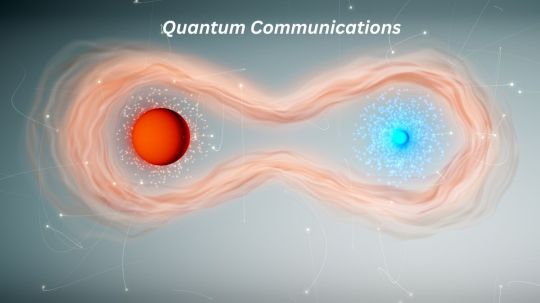#QuantumResistantCryptographic
Explore tagged Tumblr posts
Text
Quantum Communications 2025:New Inflexible Encryption

Quantum communication (QComm) uses quantum physics to safely transmit data and is growing fast. It will reach a critical point by 2025, enabling unbreakable encryption and rapid data transport. Because of its potential for groundbreaking discoveries or technological and infrastructure obstacles that could hinder its widespread adoption, this new issue is drawing major technology businesses, governments, and academic institutions.
Knowing Quantum Communication
QComm data is protected by entanglement, superposition, and quantum teleportation. Instead of computer bits, quantum communication uses qubits, small particles like photons, electrons, protons, and ions. When measured, a qubit “collapses” into 0 or 1.
One particle's state instantly impacts others regardless of distance due to quantum entanglement. Quantum state teleportation uses entangled qubits to convey information instantly, using the Einstein-Podolsky-Rosen (EPR) Paradox.
The most important QComm features are PQC and QKD.
QKD secures data and key exchange. Quantum Key Distribution sends encrypted classical bits and qubits via satellites or fiber-optic connections. When Alice and Bob exchange qubits to produce a shared random bit string, an eavesdropper (Eve) can identify flaws when measuring or intercepting qubits. The quantum physics no-cloning theorem and Heisenberg uncertainty principle state that it is impossible to replicate or measure a quantum state without changing it, making this detection possible.
Alice and Bob can start a new key creation if they suspect tampering and destroy the key if the Quantum Bit Error Rate (QBER) exceeds a threshold. E91 and BB84 are popular QKD protocols. QKD is more secure than standard encryption, however side-channel attacks and source authentication still exist. QKD is quantum communication's “first generation”.
Post-Quantum Cryptography (PQC): QRC techniques protect against large-scale Quantum Computing. Peter Shor's 1994 approach might crack most encryption protocols, including Rivest-Shamir-Adleman (RSA), in seconds on quantum computers. Lattice cryptography is often used to create PQC algorithms, which are based on mathematical problems that quantum computers may struggle with. QKD is hardware-dependent and long-term, while Post-Quantum Cryptography is software-based and short-term.
Problems and Obstacles
Despite these advances, quantum communication still faces severe barriers to popular application.
Scalability and Distance: Photon loss in fiber-optic cables limits transmission distance, however quantum repeaters are being developed to enhance range. Building a global quantum network requires expensive infrastructure.
Cost and Commercial Viability: QComm systems require complex and expensive hardware like photon detectors, dilution refrigerators, quantum repeaters, and quantum memories, most of which are currently in development with unpredictable supply chains. Over $1 billion USD is expected to be spent developing a quantum internet over 10 to 15 years. Quantum solutions are expensive, so organisations are hesitant to utilise them until costs drop and benefits become clear.
Quantum Decoherence and Error Correction: External factors impair quantum particles' information. The phenomenon called quantum decoherence. Despite quantum error correction research, effective error correction is still a long-term goal.
Governments struggle to reconcile innovation and national security as quantum encryption standards change frequently. Standards gaps hamper PQC-QKD interoperability. US, China, and EU export bans on quantum technology components for military application hamper international cooperation and information exchange.
Supply Chain Constraints: QComm hardware development requires rare and exotic raw materials like semiconductors, rare earth metals, and critical minerals, which are scarce and processed mostly in China.
skill shortfall: India is no exception to the worldwide quantum technology skill shortfall, which requires specific curricula and qualified professors. Developing a qualified workforce is challenging when career options are unknown.
Although PQC is transitory, its methods, which use current lattice encryption, may break over time. PQC algorithms use greater processing power, which may slow performance and make side-channel assaults harder to stop.
Future Hopes
Researchers predict quantum network development to accelerate through government, IT, and academic cooperation. To improve communication reliability, quantum teleportation, quantum error correction, and AI-driven quantum system optimisation are expected. Governments may also adopt clearer laws and international agreements to regulate cross-border quantum communication and encryption.
Healthcare, banking, and defence will use quantum communication as technology improves and becomes cheaper. Quantum communication will require consistent investment, strategic planning, transnational collaboration, and cunning geopolitical manoeuvring to overcome current obstacles and avert supply chain concerns. Quantum communication will show if it can overcome these obstacles or if it will still face obstacles before reaching its full potential in the next years.
#Quantumcommunication#Qubits#phenomenon#QuantumKeyDistribution#quantummechanics#QuantumBit#QuantumResistantCryptographic#PostQuantumCryptography#quantumnetwork#QComm#News#Technews#Technology#Technologynews#Technologytrends#Govindhtech
0 notes